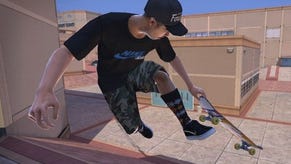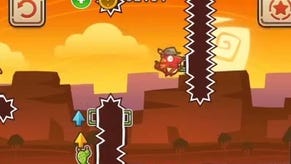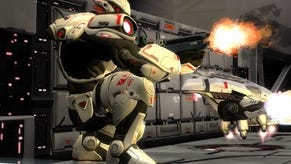Hybrid Preview: Turning the Shooter Upside Down
You can fly, but you can't walk in 5th Cell's bizarre take on deathmatch for XBLA.
5th Cell's Scribblenauts allowed players to conjure almost any object they could dream up. The first thing I created? A jetpack, because let's face it, everything is better with jetpacks. It looks like someone at 5th Cell agrees, as they've applied this wisdom to their upcoming Xbox Live Arcade game, Hybrid. Add in one of the most peculiar control schemes out there, and the concept of a multiplayer third-person shooter gets flipped on its head.
Indeed, you spend much of your time in Hybrid hanging upside down, since your gravity-defying armour allows you to perch along cover lining the ceilings and walls. In most games this would be original enough, but that wasn't enough for 5th Cell. Instead, they've chosen to throw the baby out with the bathwater and get rid of ground movement altogether.
That's right - you can fly, but you can't walk. This nonsensical restriction reminds me of Bionic Commando's Nathan "Rad" Spencer, who could swing around like Spider-Man, but couldn't jump.

Here's how it works: You fly between cover points by aiming your reticule at them and hitting A. As you're being pulled to your destination, you can strafe and shoot as though you were playing an on-rails shooter. Tap B and you'll revert back to your previous position. It's awkward and unintuitive, but certainly gets points for originality by forcing players to unlearn everything they've ever earned about controlling characters.
"I liken it a lot to League of Legends," says creative director Jeremiah Slaczka. "You get your ass kicked in League of Legends, but you're compelled to play it more because you don't feel that it's the game's fault, you feel it's you... If this game has a very difficult learning curve, then we need to embrace that and make it about people wanting to feel like they could become masters at this game."
With so much emphasis on flight, it surprised me to learn that Hybrid was initially conceived without jetpacks at all. In fact, they weren't added until a year into development.
"The original impetus was about trying to make a gameplay mode out of real world combat," Slaczka explained. "In the real world, nobody runs and guns and circle strafes. You hide behind walls, and cars, and trucks and all that kind of stuff to make sure you're not going to die, and you kind of sprint between the two covers. You don't just walk into the middle of the street and gun everybody down... So I thought, 'How could I turn that into a game mechanic where I'm forcing players to be about cover, but still allow them to feel like they have from freedom of movement?"'

Early iterations relied on flicking the analogue stick to select cover points and mashing buttons to sprint, until they devised a system where players had a choice between an automated run and a limited jetpack boost.
"We were like, 'Man, people really like this a lot more! What if we just removed the floors altogether and just made it flying from cover to cover?"' Slaczka says.
Hybrid's reliance on cover might seem like it would encourage camping - that's what I did initially - but this is generally not a successful tactic. You may spend most of your time behind cover, but that doesn't mean you're safe. The three maps available in the beta are all very tightly built around three-on-three skirmishes where nearly every cover point is exposed from at least one direction. A quick tap of the Y button will vault you over barriers, but you'll still need to zip around as each stage is designed to make opponents outflank each other. The concise levels recall the tactical team-based nature of Counter-Strike, which Slaczka cites as a major influence.
While maps are built around only six players, the battlefield gets hectic quickly thanks to a unique system where helper mechs are awarded for kill streaks (or for consecutive death streaks, out of pity.)
These mechs come in three types. Your first kill grants you a stalker, a mostly stationary turret that will hop over cover, but won't move beyond that. A kill streak of three grants a warbringer, a floating sentry that will hover around looking for foes. A kill streak of five awards a preyon, a robot sporting a female appearance that will home in on enemies, instantly killing whoever it touches. If she's hot on your six, she'll emit an unnerving banshee cry, allowing only a few seconds to shoot her down before she'll latch onto you.

As with most most shooters these days, there's a host of unlocks for higher tiers. Aside from choosing a primary weapon before each round (and the chance to alter your layout prior to respawning), you can select a specialisation such as extra armour or weapon damage, as well as a special ability. These operate on a cooldown meter and range from allowing your team see enemy locations, to gaining health by shooting foes, to hacking grenades that turn enemy mechs against their allies.
In the final version, every round will have handful of side objectives that grant extra XP if carried out successfully. Usually these are based on getting enough kills with certain weapons or special abilities. They're all optional, but exist to encourage players to experiment with various equipment.
Outside of combat, Hybrid hinges on the framework of a persistent world war. The story goes that man and alien invaders are vying for a resource called dark matter. Upon creating a profile you choose a faction - conveniently colour-coded red and blue - and the entire game is based on a race to acquire more resources. Each continent is separated into different regions, and winning matches ups your faction's influence over that territory. The first faction to claim a region 100 per cent is awarded two pieces of dark matter, while the other faction will get only one upon reaching 100 per cent. If your faction wins the world war, you'll be given a huge XP bonus and the war will start anew (though you'll still keep your experience and unlocks).
This aspect was once a much bigger part of the game. "The original concept behind Hybrid was a big global war on XBLA, and we had more strategy elements to it, but then as the game evolved organically we wanted to focus more on the battle system. Before it was a 60/40 split, or maybe even 70/30 of tactics on the world map to gameplay," Slaczka explained. "It became too much like a board game and that's not really what we wanted to do... It's an arcade game, so we didn't want to focus too heavily on the strategy element."

The larger meta-game still has an impact on how you play, though. There's a slight tactical choice depending on whether you want to play a region that allots a specific bonus to your specialisation or if you'd rather help tip the scales in your faction's favour in a contested territory. Even if your individual actions aren't drastic, the feeling that you're contributing to a larger goal adds a sense of purpose to a genre that usually consists of self-contained matches.
While Hybrid contains plenty of unique ideas in terms of control and structure, its visual style of sleek metal corridors is curiously generic. "Last year it was more post-apocalyptic and gritty, but this wasn't working for us," Slaczka explained. "It also wasn't working for us in 60 frames per second," he added, stating that grit and debris flying everywhere could be quite costly on resources, so they opted for a "cleaner, more mature look." The visuals may be serviceable, but do little to highlight Hybrid's most unique sensibilities.
I have a strong feeling that Hybrid will be one of the most divisive shooters out there when it comes out this summer on XBLA. Its uninspired aesthetics may not draw much attention, and those seeking conventional shooter familiarity will feel as if they've brought a knife to a jetpack fight. But those tired of relying on the same skills to cruise through an already oversaturated genre will likely relish getting to grips with its bizarre approach. Either way, Hybrid already looks like one of the most intriguing curios in its genre.








.png?width=291&height=164&fit=crop&quality=80&format=jpg&auto=webp)




.jpg?width=291&height=164&fit=crop&quality=80&format=jpg&auto=webp)
